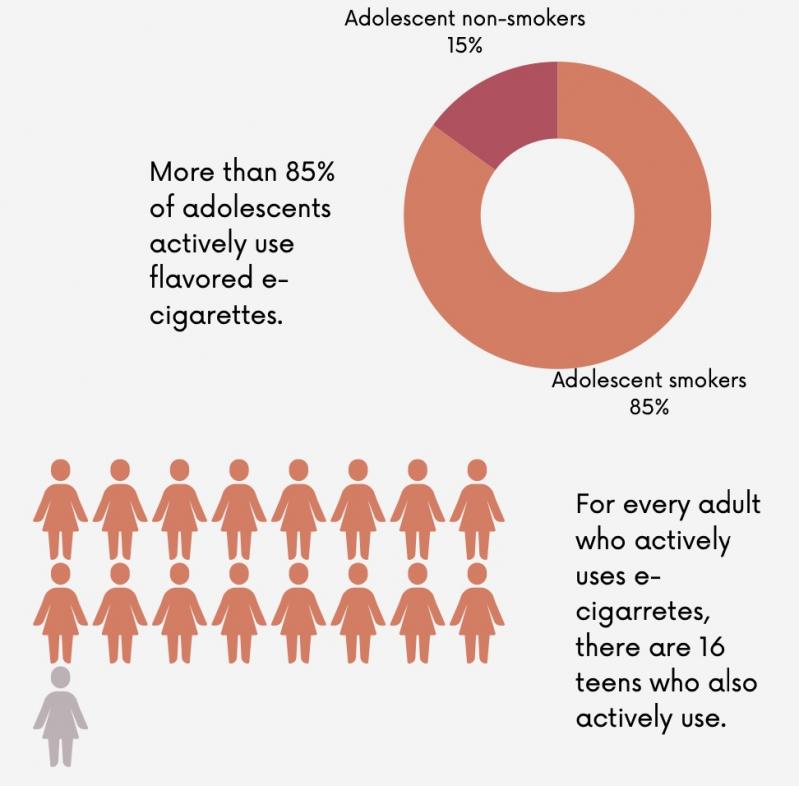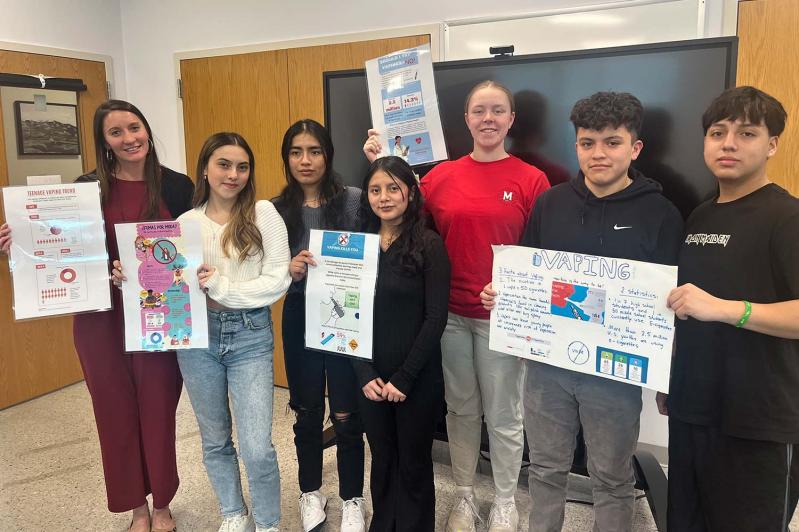Vaping addiction among teens here and at many high schools in the nation has reached epidemic-level status not seen since before the pandemic, school administrators are saying, and local students are again taking action to combat it.
Before the pandemic, several East Hampton seniors and juniors had started a campaign called Breathe for Change, at one point even testifying before a congressional committee about the evils of vaping. By the time Covid-19 happened, however, they had graduated, and their momentum was lost.
Now, students in Jessica Sanna’s health classes at East Hampton High School have taken up the cause. They are tackling the issue with infographics and research, and sharing their findings with their peers in both English and Spanish. They’ve only just begun, and appeared before the East Hampton School Board on Jan. 2 to present their work.
“Vape Free Is the Way to Be” says a poster created by Ronald Loja, a junior, and Kevin Quito, a sophomore. Susie DiSunno, a junior and three-sport athlete, focused her research on the impacts of vaping on respiratory health, which affects the ability to succeed at sports. Working together, Gabriela Quizhpi and Adriana Sagbay, who are juniors, took on mental-health aspects, and in a solo project, Ana Parra, another junior, addressed the overall trend and physical health.In a roundtable discussion on Friday, each of the students said they know someone who regularly vapes or has tried it.
“I’ve never done it and I never want to because of all the health problems, but I have been around it,” Susie said. “It’s disappointing to see. . . . It’s baffling that people do it, because it’s terrible for you.”
The students’ research included statistics from sources such as the Centers for Disease Control, the office of the Surgeon General, and the American Heart Association. Here are a few of their eye-opening conclusions:
One in seven high school students vapes — that’s more than 2.5 million teens.
Many vapes contain the nicotine equivalent of 50 cigarettes, and also contain chemicals linked to cancer.
Peer pressure is the number-one reason teens try vaping.
For every adult who regularly uses e-cigarettes, there are 16 teens who do so.

“Unfortunately, it’s everywhere,” said Sara Smith, the school principal. “It’s too easily accessible for adolescents. . . . We have to do a full-out, all-hand-on-deck student movement. We know the best way to make change among adolescents is for it to be student-led. It’s going to be so much more powerful.”
Data on the number of disciplinary incidents related to vaping at the high school was not made available by press time this week. But when these incidents are documented — and even in cases where a parent comes to the school to ask for help in breaking their teen’s habit — there is a proactive response.
“We automatically hook that person up with a counselor from Phoenix House, who provides direct individual substance-abuse counseling,” Ms. Smith said. “It’s kept very confidential on purpose.”
Why are so many teens taking up this habit?
Here’s Gabriela’s take: “Young people vape because they have an emotional issue with themselves. But it’s not going to alleviate it by vaping — you still need to seek somebody to talk to.”
“Kids see their parents or their older friends do it and see it as normal,” said Susie.
Through a translator, Ana said she is “shocked how easily accessible everything is, not just for vaping. Marijuana brownies, cookies, gummies, edibles — so easy to get a hold of.”
The students’ upcoming plans include social media campaigns, school assemblies, and small-group events. Susie suggested reaching out to the BBS Current and the Bonac Beachcomber, the school’s broadcast and print-news groups. She suggested the issue be addressed for each sports team at the start of the season. Kevin suggested having a panel discussion similar to a recent event in which E.H.H.S. alumni returned to school to talk to juniors and seniors about college life.
Ana suggested that “whatever it is, make it pop out” with attractive colors, “so that your eyes look at it.” The Spanish-language component is extremely important, she stressed. “If everything is in English, kids who don’t read or speak English yet are just going to move on. If it’s in Spanish, they’re going to read it.”
Pierson High School in Sag Harbor, according to Jeff Nichols, the district superintendent, “hasn’t had as many vaping incidents as we had going back a couple of years ago.” He suggested that the decline might be tied to another issue: cellphone addiction. Pierson Middle and High School administrators adopted a strict no-phones-in-school policy this year, which has helped.
“Communication about meeting up and [vaping], if that was a method through which students were communicating, maybe that contributed to the decrease” in vaping, Mr. Nichols said. “I’m comfortable noting this year that it has gone down.”
Bridgehampton School District officials did not respond to a request for comment by press time.

